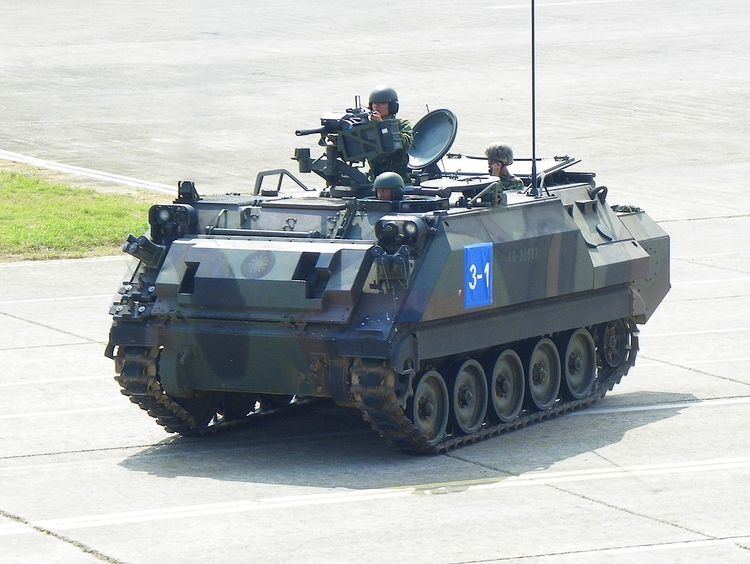Place of origin Republic of China Used by Republic of China | In service 1982-present Designed 1970s | |
 | ||
Type Armored Personnel Carrier Designer Armored Vehicle Development Center | ||
The CM-21 is an armored vehicle designed and manufactured by the Republic of China Armored Vehicle Development Center, based on the United States' model M113 APC. The first prototype was rolled out in 1979, with the vehicle officially entered service in 1982. The CM-21 is still in use today, with over 1,000 units manufactured across the variety of different variants.
Contents
History
At the end of 1967, the United States and the Republic of China signed the "Third-Nation Overhaul Program" and began to repair United States equipment in Vietnam until the end of the Vietnam War, thus accumulating experience in the overhauling, welding, parts manufacturing, vehicle assembling and testing of the M113 APC. In 1975, The Combined Logistics Command carried out the "Wan Cheng Program" (萬乘計劃), to domestically produce three M113 hulls using the aluminum alloy plates produced by Taiwan Aluminum Corporation (Today's Chinese Steel Aluminum Corporation). The Wan Cheng 1 was an imitation of the M106 4.2 inch mortar carrier, but the Howitzer was replaced with a Type 63 120 mm Howitzer, and this innovation later became the CM-22 Howitzer carrier. The Wan Cheng 2 had a M113 hull with a M24 turret, and the engine was moved to the rear; it was a lighter version of the M113. The Wan Cheng 3 had mounted a "Worker Bees IV MLRS" (工蜂四型多管火箭), a Multiple Launch Rocket System (MLRS). The MLRS was later mounted on six more US made M113s. (One M48A1 was re-fit to a M48A5, and was called the Wan Cheng 4). The Wan Cheng Program provided a solid foundation for the design, manufacture and development of the CM-21.
Design
The Standard version of CM-21 is an armored personnel vehicle (APV), using the engine and transmission from the M113 series. It can carry up to 12 soldiers, and has basic armor capability. The hull is welded aluminum alloy armor, and the front and rear armors are spaced armor, filled with polyurethane to absorb the energy of projectiles. Overall, the CM-21 is better protected than the M113, but the CM-21 is 400 kilograms heavier than the M113 and has slightly inferior mobility.
There are two firing ports on each side of the hull and one on the rear. Therefore, soldiers are sitting face to face in the front of the passenger compartment, and back to back in the rear. The CM-21 has floating capability, meaning it is able to cross water that is up to 1.5 meters deep without extra reinforcement. There are two water pumps that are switched on to lower the front flap. It is also propelled by tracks while in water, without additional blades. Just like M113, CM-21 can also mount external fuel tanks on the rear. The basic armament of CM-21 is one M2 Browning machine gun or Mk 19 automatic grenade launcher, and a quad-mounted smoke grenade launcher on both sides of the front. A CM-21 was discovered carrying an M2 and an Mk 19 at the same time by using a bi-mounted gun rack.
CM-21A1
The CM-21 models currently in service are CM-21A1. The CM-21 is still a basic Armored Personnel Carrier, and it cannot be upgraded to the CM-21A2 Infantry Fighting Vehicle. Also, with the introduction of CM-32 wheeled Armored Vehicle, it is more unlikely that the CM-21A1 will receive an upgrade.
CM-21A2
CM-21A2 is a modified version of CM-21A1, inspired by the American M1132A2. The engine's intake has been modified to take air from the inside of the vehicle, rather than using exhausted gas, which reduces the crew's performance in combat. The side armor is also replaced with a net armor to protect the vehicle from anti tank weapons with shaped charges.
CM-21A2 is predicted to be directly upgraded into an infantry fighting vehicle, and was tested with a French GIAT Dragar 25 mm gun turret, but it was not accepted; a simple command turret was also added for the testing.
CM-22 Mortar Carrier
CM-22 is a variant of CM-21 with a 107/ 120 mm mortar, very similar to the American M106 mortar carrier. CM-22 was developed in 1987 and was still in production in 1999, but the ammo rack is different with M106 in the late version of CM-22, along with parts from CM-21 such as headlights.
The passenger compartment is modified to carry mortar, and cancelled firing ports and spaced armor. The exterior of CM-22 is basically the same as M106.
CM-23 Mortar Carrier
CM-23 is a variant of CM-22 with an 81 mm mortar, identical to the American M125.
CM-25 TOW Launcher
CM-25 is a variant of CM-21 which has the capability of firing TOW Missile, in order to engage armored targets. CM-25 has a modified passenger compartment to store TOW missiles, and has replaced the quad-mounted smoke grenade launches with triple mounted ones. It also cancelled the firing ports and extended the spaced armor, but the protection of CM-25 is not any stronger. The CM-25 is only operated by Republic of China Marine Corps, while the Republic of China Army is still operating M113A1 TOW Launcher. The spaced armor of CM-25 is filled with polystyrene to increase buoyancy for the Marine Corps' amphibious operations.
CM-26 Command Track
CM-26 is a command track derived from CM-22, and it is similar to the American M577.
